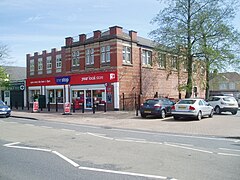Langold
| Langold | |
|---|---|
 The One Stop Shop, which was originally the Co-op when it opened in 1925. The upstairs was used as a school, Sunday school and dancehall. |
|
| Langold shown within Nottinghamshire | |
| Population | 2,472 (Ward. 2011) |
| OS grid reference | SK584871 |
| District | |
| Shire county | |
| Region | |
| Country | England |
| Sovereign state | United Kingdom |
| Post town | WORKSOP |
| Postcode district | S81 |
| Dialling code | 01909 |
| Police | Nottinghamshire |
| Fire | Nottinghamshire |
| Ambulance | East Midlands |
| EU Parliament | East Midlands |
| UK Parliament | |
Langold is a village in Bassetlaw, North Nottinghamshire. At the 2011 census it was defined as a ward of Bassetlaw Council with a population of 2,472. It was built to provide housing for the miners of Firbeck Colliery between 1923 and 1927, and Langold Lakes Country Park is situated on the south-western edge of the village.
While there are references to settlement in the geographical area which is now Langold from 1246, before the early twentieth century it consisted of farmland and parkland in the estates of Firbeck and Hodsock. Hodsock Priory and estate with its farms, and much of Carlton-in-Lindrick were bought by the Mellish family in 1765, parts of which they sold on to Ralph Knight of Langold. Knight created plantations and a lake in Langold Park, and intended to build a mansion, but little work had been done on this when he died in 1768.
Ralph Knight was unmarried, and so the estate passed via his sister to his nephew, John Gally Knight, while another nephew, Henry, lived at Firbeck Hall. Both estates passed to Henry's son, also called Henry, who again planned a large mansion overlooking the lake, but although he commissioned Sir Jeffry Wyatt to draw up plans, no construction took place. Langold Hall was described as "a farmhouse" in William White's gazetteer of 1838. The Langold estate passed to Sir Thomas Wollaston White in 1846 and to Sir Archibald Wollaston White of Wallingwells in 1907. It consisted of a farm and the hall, situated close to the Worksop to Tickhill turnpike road, which had been constructed in 1767.
Sir Archibald Wollaston White sold the Langold estate to Thomas Place of Northallerton in early 1927, once coal had been found, and Place sold it to the Firbeck Colliery Company in July 1927.
By 1911, mining in the area suggested that there may be a workable seam of coal at Langold. The Wallingwells Boring Company was created, and German engineers carried out some test drilling in a field which was part of Costhorpe Farm. Although the initial tests were good, the First World War brought a stop to the work. The Firbeck Light Railway was authorised in 1916, but no further development took place until 1923.
A further survey of the potential coal reserves took place in May 1923, and sinking of the No. 1 Shaft began on 16 July, with construction of the No. 2 Shaft following on 15 August. Each shaft was cemented for the first 390 feet (120 m) to prevent water entering it. Work stopped at 450 yards (410 m), when water flooded the workings, and pumps had to be installed. In mid 1925, the shafts reached the Barnsley coal seam, at a depth of 828 yards (757 m), and the seam continued downwards for another 28 yards (26 m). The headgear for the shafts was completed by late 1923, and a 180-foot (55 m) chimney was constructed in under 13 weeks. Six boilers supplied steam for the winding engines, and a Baume washer capable of washing 160 tons of coal per hour was installed.
...
Wikipedia

